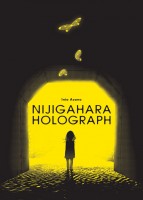 Creator: Inio Asano
Creator: Inio Asano
U.S. publisher: Fantagraphics Books
ISBN: 9781606995839
Released: March 2014
Original release: 2006
Nijigahara Holograph, the third manga by Inio Asano to have been licensed in English, was one of my most highly anticipated manga releases for 2014. Originally published in Japan in 2006, Fantagraphics’ English-language edition is collected in an attractive, large-trim hardcover much like its other manga releases. I had previously read and greatly enjoyed Asano’s other manga currently available in English—What a Wonderful World! and Solanin, both published by Viz Media—so I was naturally interested in Nijigahara Holograph. But after seeing an early preview of the manga, I knew that I would need to read it no matter what. The sequence, taken from near the end of Nijigahara Holograph, was so chilling and unsettling and at the same time so striking and beautiful that it left a huge impression on me. I couldn’t get that short segment of Nijigahara Holograph out of my mind, my anticipation only growing stronger the closer the manga’s release date came.
Eleven years ago Arie Kimura, a young girl bullied by her classmates, fell down a well. As a result of her injuries she has been in a coma ever since. She told a story about a monster that lived in a tunnel along the Nijigahara embankment that would bring the world to an end, which terrified the other children. Arie’s accident is only one small part of an ongoing pattern of fear and violence. It isn’t a pleasant memory for anyone involved. Her friends, classmates, teachers, and family members have continued living their lives, but even more than a decade later they still can’t escape their pasts and the consequences of their actions. Some of them live in denial while others have tried to move on and to forget, but for some that is a complete impossibility. They have no choice but to remember, tormented with the knowledge of the suffering and pain caused by the unnecessary tragedy. The story of the monster in the tunnel may be more real than any of them could have imagined.
Nijigahara Holograph is a dark and disconcerting work. The manga deals with some very heavy subjects: suicide, incest, abuse, and sexual and physical violence, among many other serious matters. Instead of being sanitized or romanticized, Asano has created an intensely disturbing tale in which all of these elements are incorporated and intertwined. Nijigahara Holograph is open to several interpretations. It’s dreamlike ambiguity makes it difficult to determine just how much of Nijigahara Holograph is real and how much of it is simply the product of the damaged psyches of the characters. It cold be a waking nightmare, it could be some sort of afterlife, or it could all be true. It would almost be comforting if Nijigahara Holograph was a portrayal of hell or purgatory; the possibility that it shows the characters’ reality is terrible to contemplate. But life isn’t always pretty and sweet, and it certainly isn’t in Nijigahara Holograph where innocence, minds, and bodies have been shattered.
As horrifying and distressing as Nijigahara Holograph is, the manga is also extraordinarily compelling and engaging. It is both brutal and beautiful. Nijigahara Holograph is also remarkably complex and layered—the characters, their lives, and their stories connect and overlap, often in unexpected and surprising ways. This is reinforced by Asano’s artwork. Visual cues are incorporated throughout Nijigahara Holograph which tie the narrative together, drawing upon the similarities between the characters and their circumstances. The parallels found in both the artwork and the story of Nijigahara Holograph are marvelously effective, underscoring the ever-increasing sense of despair as the characters are caught in a never-ending cycle of anguish and misery. Nijigahara Holograph is a work that can be and maybe even should be read several times. The clues are all there from the very beginning, but many of the subtle connections can only be seen in retrospect. It’s challenging and not always an easy read, but Nijigahara Holograph is definitely a manga that I’ll be thinking about for quite some time.








